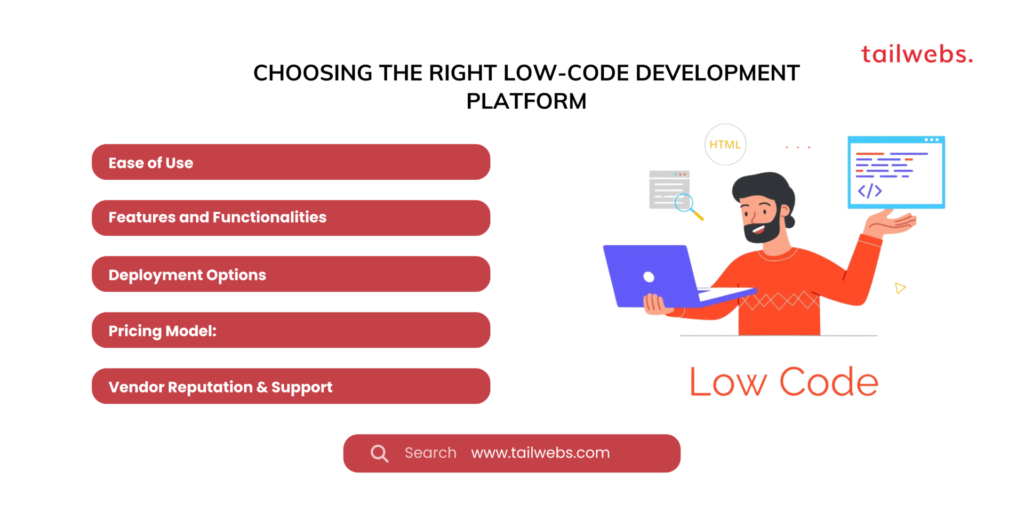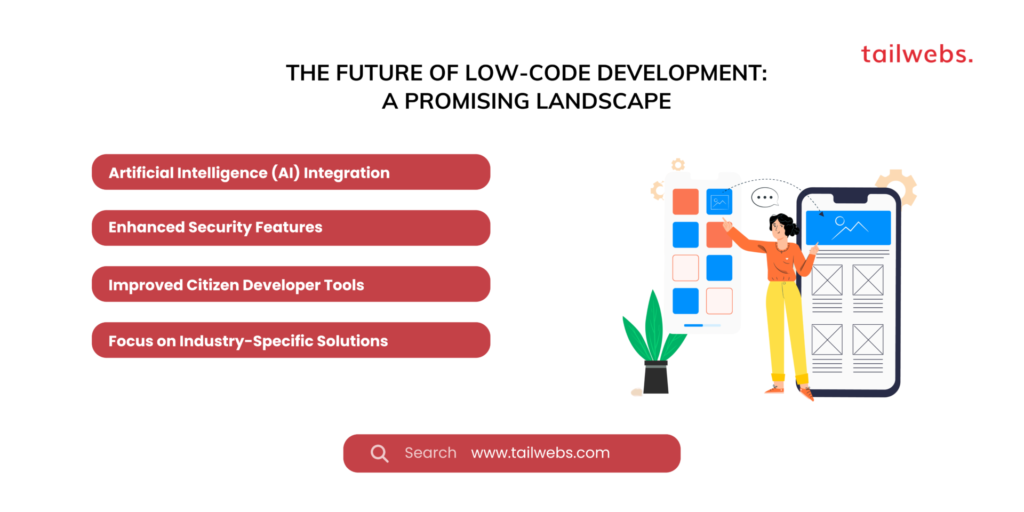The digital landscape is constantly evolving, and the demand for custom software solutions is ever-growing. However, traditional software development can be a time-consuming and expensive endeavor, often requiring specialized coding skills and significant IT resources. This is where low-code development emerges as a game-changer.
Low-code development platforms (LCDPs) empower businesses to build custom applications with minimal coding. These platforms utilize visual tools, drag-and-drop functionalities, and pre-built components to streamline the application development process. As a result, low-code development is democratizing software creation, making it accessible to a broader range of individuals and businesses, even those without extensive programming expertise.
This comprehensive guide dives into the world of low-code development, explores its potential benefits and drawbacks, and helps you determine if a low-code approach is the right fit for your business needs.
The Growing Popularity of Low-Code Development
The low-code development market is experiencing significant growth, driven by several factors:
Increased Demand for Custom Software:
Businesses across industries require custom software solutions to automate tasks, improve efficiency, and gain a competitive edge. Low-code offers a faster and more cost-effective way to meet these demands.
Skills Gap in Software Development:
The IT industry faces a persistent shortage of skilled software developers. Low-code platforms bridge this gap by enabling citizen developers (business users with basic technical knowledge) to contribute to application development.
Advancements in Low-Code Technology:
LCDPs are constantly evolving, offering more sophisticated features, functionalities, and integrations with existing technologies. This makes them suitable for building increasingly complex applications.

Benefits of Low-Code Development for Businesses
Here’s a breakdown of some key benefits low-code development offers to businesses:
Faster Development & Time to Market:
Low-code platforms significantly reduce development time compared to traditional coding methods. This allows businesses to get their applications up and running faster, capitalizing on market opportunities sooner.
Reduced Development Costs:
By minimizing the need for extensive coding and specialized developers, low-code development leads to cost savings. Businesses can build applications with fewer resources, freeing up budget for other initiatives.
Improved Business Agility:
Low-code enables businesses to adapt to changing needs and requirements more quickly. Applications can be easily modified and updated without lengthy development cycles, fostering business agility in a dynamic environment.
Empowering Citizen Developers:
Low-code platforms empower citizen developers within your organization to contribute to application development. This frees up IT resources for more complex tasks and leverages the business knowledge of citizen developers.
Simplified Integration:
Modern LCDPs offer seamless integration with existing enterprise systems and cloud platforms. This eliminates data silos and streamlines overall business processes.
Potential Drawbacks of Low-Code Development
While low-code development offers numerous advantages, it’s essential to consider some potential drawbacks:
Vendor Lock-In:
Some low-code platforms can lock you into their ecosystem, making it difficult to migrate applications to another platform in the future. Carefully evaluate vendor lock-in potential before choosing an LCDP.
Limited Customization:
While offering flexibility, low-code platforms might have limitations in terms of deep customization for highly specialized applications. For complex applications requiring extensive coding, traditional development approaches might be more suitable.
Security Considerations:
Security is paramount for any application. Ensure your chosen LCDP prioritizes data security and offers robust security features to protect your business information.
Scalability Limitations:
Not all low-code platforms are built for scalability. Evaluate the scalability potential of the LCDP to ensure it can accommodate your application’s growth and future needs.
Integration Challenges:
While many LCDPs offer pre-built integrations, some integrations might require custom development efforts. Factor in potential integration challenges when planning your low-code project.
Is Low-Code Development Right for Your Business?
Here are some key questions to consider when evaluating if a low-code approach aligns with your business needs:
Complexity of the Application:
For highly complex applications with unique functionalities, traditional development might be a better choice. However, low-code can be suitable for simpler applications or applications with existing pre-built functionalities within the LCDP.
Technical Expertise:
If your organization lacks in-house coding expertise, low-code development can empower citizen developers to take the lead on application development.
Project Budget & Timeline:
Low-code development is generally faster and more cost-effective than traditional development. If your project has a tight budget and requires a quicker turnaround time, low-code is a compelling option.
Evaluating Your Application Needs
Before diving headfirst into low-code development, thoroughly analyze the application you envision building. Here are some aspects to consider:
Application Functionality:
Clearly define the functionalities and features your application requires. Low-code platforms offer a variety of pre-built components and functionalities. Ensure the chosen LCDP can cater to your specific needs.
Integration Requirements:
Does your application need to integrate with existing systems or data sources? Evaluate the integration capabilities of the low-code platform you’re considering.
Security Needs:
Security is paramount. Assess the security features offered by the LCDP, including data encryption, access controls, and compliance certifications.
Scalability Potential:
Consider how your application might evolve and grow in the future. Choose a low-code platform that can scale to accommodate your application’s increasing demands.
Choosing the Right Low-Code Development Platform
With a multitude of low-code platforms available, selecting the right one requires careful evaluation. Here are some key factors to consider:
Ease of Use:
The platform’s user interface and learning curve are crucial. Opt for a platform that is intuitive and easy for your development team (including citizen developers) to learn and use.
Features and Functionalities:
Ensure the platform offers the features and functionalities you need to build your desired application. Evaluate pre-built components, integrations, and customization capabilities.
Deployment Options:
Consider your preferred deployment model (cloud-based, on-premise, or hybrid). Choose an LCDP that aligns with your deployment strategy.
Pricing Model:
Low-code platforms have varying pricing structures. Evaluate the pricing model, considering factors like user licenses, features included, and potential additional costs.
Vendor Reputation & Support:
Research the platform provider’s reputation, customer reviews, and support options. Ensure they offer reliable customer support to assist you throughout the development process.

Ensuring the Success of Your Low-Code Development Project
Here are some best practices to ensure the successful implementation of your low-code development project:
Clearly Define Project Goals & Scope:
Establish clear goals and scope for your project upfront. Define what you want the application to achieve and its intended users.
Assemble the Right Team:
Build a development team with a combination of business expertise and technical understanding of the low-code platform.
Prioritize Data Security:
Implement robust security measures to protect sensitive data throughout the development process and application deployment.
Focus on User Experience (UX):
Design an intuitive and user-friendly interface for your application to ensure a positive user experience.
Iterate & Refine:
Low-code development is iterative. Plan for ongoing testing, user feedback integration, and application refinement based on user needs.
The Future of Low-Code Development: A Promising Landscape
The future of low-code development is brimming with potential. Here are some exciting trends shaping the low-code landscape:
Artificial Intelligence (AI) Integration:
Expect to see increased integration of AI capabilities into LCDPs. This will enable features like intelligent code generation, automated testing, and data-driven application insights.
Enhanced Security Features:
Security will remain a top priority. Low-code platforms will incorporate advanced security features to address evolving cyber threats and ensure application security.
Improved Citizen Developer Tools:
LCDPs will offer even more user-friendly tools and functionalities, empowering citizen developers to contribute more significantly to application development projects.
Focus on Industry-Specific Solutions:
Low-code vendors are likely to develop industry-specific solutions with pre-built components and functionalities tailored to address the unique needs of different industries.

Conclusion: Leveraging Low-Code for Business Advantage
Low-code development offers a compelling approach to building custom software solutions for businesses of all sizes. By carefully evaluating your needs, choosing the right platform, and implementing best practices, you can leverage low-code development to streamline processes, boost efficiency, and gain a competitive edge. As low-code technology continues to evolve, it has the potential to democratize application development further, empowering businesses to innovate and thrive in the digital age.





